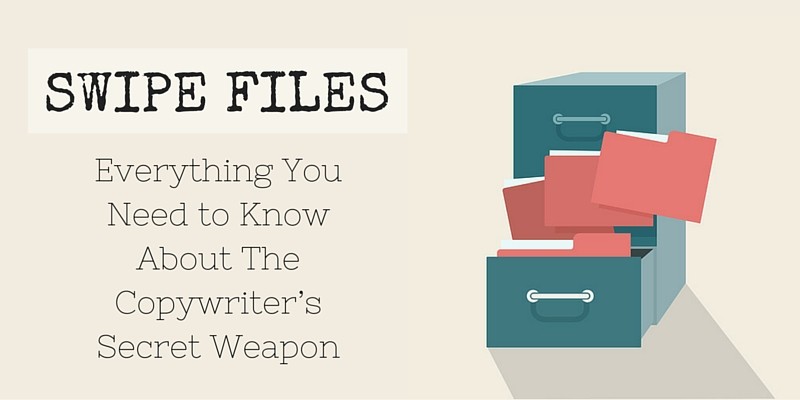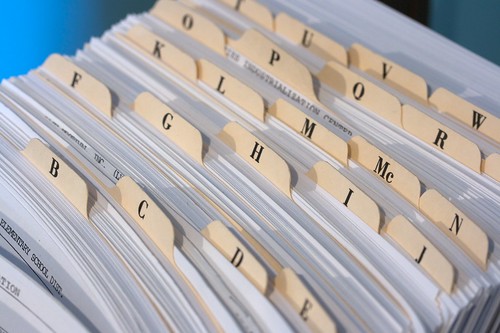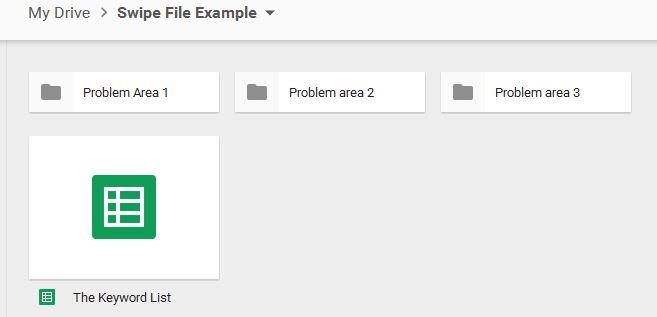“Good Artists Copy. Great Artists Steal”- Pablo Picasso
Steve Jobs, who attributed this saying to Pablo Picasso, embodied this concept as a core philosophy in his construction of the mega-brand Apple has become today. What did Jobs find so endearing about this line?
The answer is Steve Jobs intuitively knew what all the great copywriters know: all great ideas start from a swipe file.
You might be thinking “But swiping sounds like plagiarizing…I don’t want to grow my business by stealing!”
That’s a perfectly valid concern. Which is why the first thing we’re going to cover is what a swipe file is versus what a swipe file isn’t. Then we will get into why a swipe file is important for your business, as well as how to build and use a swipe file.
Swipe File Misconceptions
Before we get into what a swipe file is, let’s start with some common misconceptions regarding the swipe file.
1. The name swipe file makes it sound like a sleazy sales tactic
When I first read the term swipe file, my mind scanned the hours I’ve spent watching Dora the Explorer with my niece, and it came up with an image of Swiper the Fox.
In the show, Swiper is a bandit who is always trying to steal something from Dora and her monkey sidekick Boots. A running gag of the show is he always gets caught when Dora yells “ Swiper, no Swiping!”
This negative connotation actually kept me from seeing the value of swipe files sooner. I felt like using the ideas of others was stealing, but an internship with a content marketer opened my eyes to what a swipe file really was.
2. Swipe files are a technical tool only meant for copywriters
Another common misconception is swipe files are only for copywriters. Most articles on building swipe files refer to headlines, leads, sub-headlines, and other copy-based aspects useful for copywriters.
The reality is that swipe files are a lot less technical than you would think. In fact, Pinterest is essentially a social media platform that revolves around swipe files!
Take recipes for example. Pinterest is a gold mine for recipes. If you make a board titled “Recipes” and pin all the great recipes you find, then congratulations: you’ve created a swipe file. It really is that simple.
3. A swipe file made by someone else will be effective as one you’ve made yourself
There are some less-than-ethical marketers out there who will try to sell bloggers and small businesses swipe files as if that particular swipe file is the magic solution to their marketing problems. This is completely false
A huge part of what makes a swipe file effective is that it was created by you. A swipe file is more than the collection of documents itself; it’s the comments you add to these documents. What about that article inspired you? What about that ad do you want to try for your small business? These are the types of questions that you should be answering whenever you add a document to your swipe file.
The other reason why a cookie-cutter swipe file created by someone else doesn’t work is that an effective swipe file must be added to daily. If you don’t add to a swipe file daily, then eventually the idea well runs dry.
The best way to get the maximum benefit from a swipe file is to make adding to it part of your daily routine. Take 10 minutes with your morning tea or coffee and search the web for anything that inspires you.
We’ll be getting into the details of building an effective swipe file shortly, but first let’s define the swipe file now that we’ve cleared up some common misconceptions.
Swipe Files Defined
In this 2011 article titled “Do You Have a Swipe File”, Christopher Penn defines the swipe file as a collection of files designed to help the user break through a creative block. The second part of the previous sentence is the important part.
The factor that makes a collection of files a swipe file is that each file contributes inspiration towards breaking that specific file’s block. Let’s look at an example.
Say you are an aspiring chef who just launched their private chef small business. You know you have the cooking skills, but you are clueless when it comes to branding, marketing, and everything else that goes along with building a small business.
You come across an article on swipe files and decide to build one for your small business. You head to Pinterest and start pinning recipe ideas, kitchen designs, marketing advice for chefs, and business plan tips. After a couple of hours and a couple hundred pins, you feel like your swipe file is complete. Nope. What you have
1. Segment your pins into specific boards
Segmentation is something marketers do to more specifically target a portion of their audience. Swipe this concept from the marketers and have a separate file for each specific block, which is what Christopher Penn suggests in his aforementioned article on swipe files.
Step back into that aspiring chef’s shoes. You look at your collection of pins and find they’re mostly in 3 categories: equipment reviews, recipe ideas, and personal branding tips. Create a separate board for each of these categories and re-organize your pins into their proper category to complete step 1.
2. Write what specifically inspired you in the description of each pin
The next step is to go to each pin and add in the description what inspired you. You may think that you’ll remember just by looking at the pin, but some things will inevitably slip through the cracks. The more detailed you are, the easier swiping will be.
3. Add to your boards daily
Step 3 is merely applying steps 1 and 2 daily. As mentioned earlier, set aside at least 10 minutes a day to add to your swipe file. For this Pinterest example, make your goal to add one file daily to each of your problem boards.
Don’t use Pinterest? Don’t sweat it! There are several tools you can use to build your swipe file. Let’s look at building a more in-depth swipe file using Google Drive.
The Elements of A Swipe File
Now that you got the concept of a swipe file down, let’s walk through building a swipe file using Google Drive. The first thing you’re going to want to do is
1.The Keyword List ( Sheet)
A keyword list is essential for finding relevant information quickly through the use of search engines.
Coming up with a keyword list is easier than it sounds. The first question you ask yourself is “What are my problems?”
If we go back to the personal chef example, that person’s answers would be as follows.
“ I need to get more creative in the kitchen.”
“ I need better equipment.”
“ I need a personal brand that makes people want to hire me.”
Here’s a list of sample keywords from those answers:
- Top kitchen equipment
- Personal branding strategies
- Creative recipes
- Experimental cooking
- Tips for becoming more creative in the kitchen
Once you have your list of keywords, throw them in a Google sheet titled “ Swipe File Keywords”. Make sure it’s in your “Swipe File” folder.
2. The Source List (Sheet)
Once you have your keywords, then you’re ready to find sources. Before you start hunting, make sure to create a separate folder within the “Swipe File” folder for each of your problem areas (just like the first step of the Pinterest example.)
Now that you’ve got your folders labeled, start using those keywords on your search engine of choice. Creating a Google Sheet to keep track of the most influential blogs that pop up for that keyword. You can dig as deep as necessary, but for your first swipe file stick with those who pop up on the first results page.
Make a routine of checking these sites for new information you can swipe. Create a Gmail account specifically dedicated to subscribing to blog email lists. Check this every morning and you’ll get all the source material you need for your inbox.
3. The Database (Docs and Sheet)
The database is the command center of the swipe file. The first thing you’ll want to do is create a Google Sheet for each keyword and put it in its respective problem folder. This is where you’ll have a link to each document you swipe, as well as the source of the document.
The next thing you’ll be doing is creating a Google Doc for each keyword. You’ll post the links to your swipe documents here as well, but you’ll also include what specifically inspired you about each document.
Now all you need to do is browse your sources and start building your swipe file- happy swiping!





